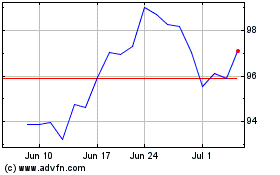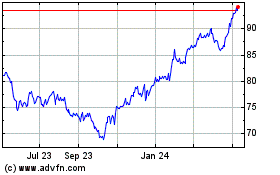Trade Deficit Both Up and Down - Analyst Blog
December 09 2011 - 7:00AM
Zacks
The Trade Deficit fell in October to $43.47 billion from $44.17
billion, but the decline was only due to an upward revision to
September from $43.11 billion. Thus, you could see it as a 1.6%
decline, or a 0.8% increase depending if you use the current or
original figures for September. It was better than the expected
level of $44.0 billion. Factor in both the beat and the revisions
and call it an in-line report.
On a year-over-year basis, the total trade deficit was up by 10.2%
from $39.45 billion. The trade balance has two major parts: trade
in goods and trade in services. America’s problem is always on the
goods side; we actually routinely have a small surplus in
services.
Relative to September, the goods deficit fell to $58.78 billion
from $59.51 billion (revised up from $58.90 billion). Relative to a
year ago, the goods deficit was up 12.0% from $52.50 billion. The
Service surplus was down slightly from September to $15.32 billion
from $15.34 billion (revised down from $15.79 billion). Relative to
a year ago, it is up 18.9% from $12.89 billion.
Exploring Exports
Exports of goods fell by $1.49 billion, or 1.15%, for the month to
$127.78 billion. Relative to a year ago, goods exports are up
13.52%. In other words, we are slightly the pace to meet President
Obama’s goal of doubling exports of goods over the next five years.
On a year-to-date basis, goods exports are up 17.62%, above the
pace needed to double over five years.
Service exports were up slightly for the month to $51.39 billion,
from $51.35 billion, but September was revised up from $51.09
billion. They are up 9.46% year over year, which is well short of
the pace needed to double over five years (just under 15%). Total
exports fell 0.80% for the month to $179.17 billion and are up
12.33% year over year, below the pace needed to double over five
years. On a year-to-date basis, total exports are up 15.52%,
slightly above the doubling pace.
Doubling exports over five years is all well and good, but not if
we also double our imports over the same time frame. After all, it
is net exports which are important to GDP growth, and to
employment. For the month, total imports fell by 0.96%, but are up
11.90% year over year and by 14.45% on a year-to-date basis.
Inspecting Imports
Relative to a year ago, goods imports were up by $21.66 billion, or
by 13.14%. At that pace, they are below the pace needed to double
over five years. However, since they at starting from a higher
base, the dollar increase is much bigger than the $15.22 billion
increase in goods exports. Service imports were up by $6 million on
the month, or 0.02%.
In October, we bought from abroad $1.460 worth of goods for every
dollar of goods we sold, the same as in September, and down from
$1.46.5 a year ago. Including services, we imported $1.243, down
from $1.245 in September, and down from $1.247 a year ago.
Trade in goods simply swamps trade in services, even though
services are a much larger part of the overall economy. So far in
2011, the total trade deficit is up 10.57% from the first ten
months of 2010. The goods deficit is up 13.80%, offset by a 22.26%
increase in the service surplus. Year to date, our deficit with the
rest of the world is $465.22 billion, up from $420.73 billion in
the first ten months of 2010.
Trade & Recession
All things being equal, it is better to see trade going up than
down. Increasing trade tends to increase the size of the overall
pie, but also tends to rearrange the size of the slices within a
country. We want to see both exports and imports growing, but given
the massive deficit we are running, we need to have exports rise
dramatically faster than imports, or actually see imports fall.
From a purely nationalistic point of view, rising exports or
falling imports are roughly equivalent in terms of economic growth.
Falling imports though implies economic pain in some other
countries. Thus, all else being equal, it would be better if most
of the improvement in the trade deficit came from rising exports
rather than falling imports.
A big part of what made the Great Recession into a global downturn
was an absolute collapse in global trade. This can clearly bee seen
in the long-term graph of our imports and exports below (from
http://www.calculatedriskblog.com/).
Falling imports and exports are clearly associated with recessions.
In the Great Recession our imports collapsed faster than our
exports, and so we had a very big improvement in the trade deficit.
Thus this months decline in both imports and exports is troubling
and suggests that the financial turmoil in Europe is having an
effect.

Falling imports were just about the only thing keeping the economy
on life support during those dark days. That, however, was just a
transmission mechanism that spread the recession to the rest of the
world. Thus, growing world trade is a good thing, but not if it
comes at the expense of an ever rising U.S. trade deficit. In other
words, all things else are not equal.
In the last two quarters, a reduction in the trade deficit added
slightly to GDP growth. Absent the aid from trade growth would have
been 1.51% in the third quarter, not 2.00%, and in the second
quarter it would have been 1.06%, not 1.30%. A rise in the trade
deficit was a drag in the first quarter, and without that drag
growth would have been 0.74% instead of just 0.40%. However, any
trade deficit at all is a subtraction from the overall level of
GDP.
Trade Is the More Serious Deficit
The trade deficit is a far more serious economic problem,
particularly in the short to medium term, than is the budget
deficit. The trade deficit is directly responsible for the increase
in the country’s indebtedness to the rest of the world, not the
budget deficit. That is not just a matter of opinion, it is an
accounting identity.
Think about it this way: during WWII the federal government ran
budget deficits that were FAR larger as a percentage of GDP than we
are running today, but we emerged from the war the biggest net
creditor to the rest of the world that the world had ever seen up
to that point. Then the federal government owed a lot of money, but
it owed it to U.S. citizens, not to foreign governments.
Slowly but surely the trade deficit is bankrupting the country.
While most of the foreign debt is in T-notes, try think of it as if
we were selling off companies instead of T-notes. This month’s
trade deficit is the equivalent of the country selling off
Colgate Palmolive (CL), while last month’s deficit
was the equivalent of selling off Nike (NKE).
How long would it take before every major company in the U.S. is in
foreign hands if this keeps up? Put another way, the 2010 trade
deficit totaled $497.82 billion, which is 64% what all the firms in
the S&P 500 earned, worldwide, in 2010.
COLGATE PALMOLI (CL): Free Stock Analysis Report
NIKE INC-B (NKE): Free Stock Analysis Report
Zacks Investment Research
Colgate Palmolive (NYSE:CL)
Historical Stock Chart
From May 2024 to Jun 2024

Colgate Palmolive (NYSE:CL)
Historical Stock Chart
From Jun 2023 to Jun 2024
